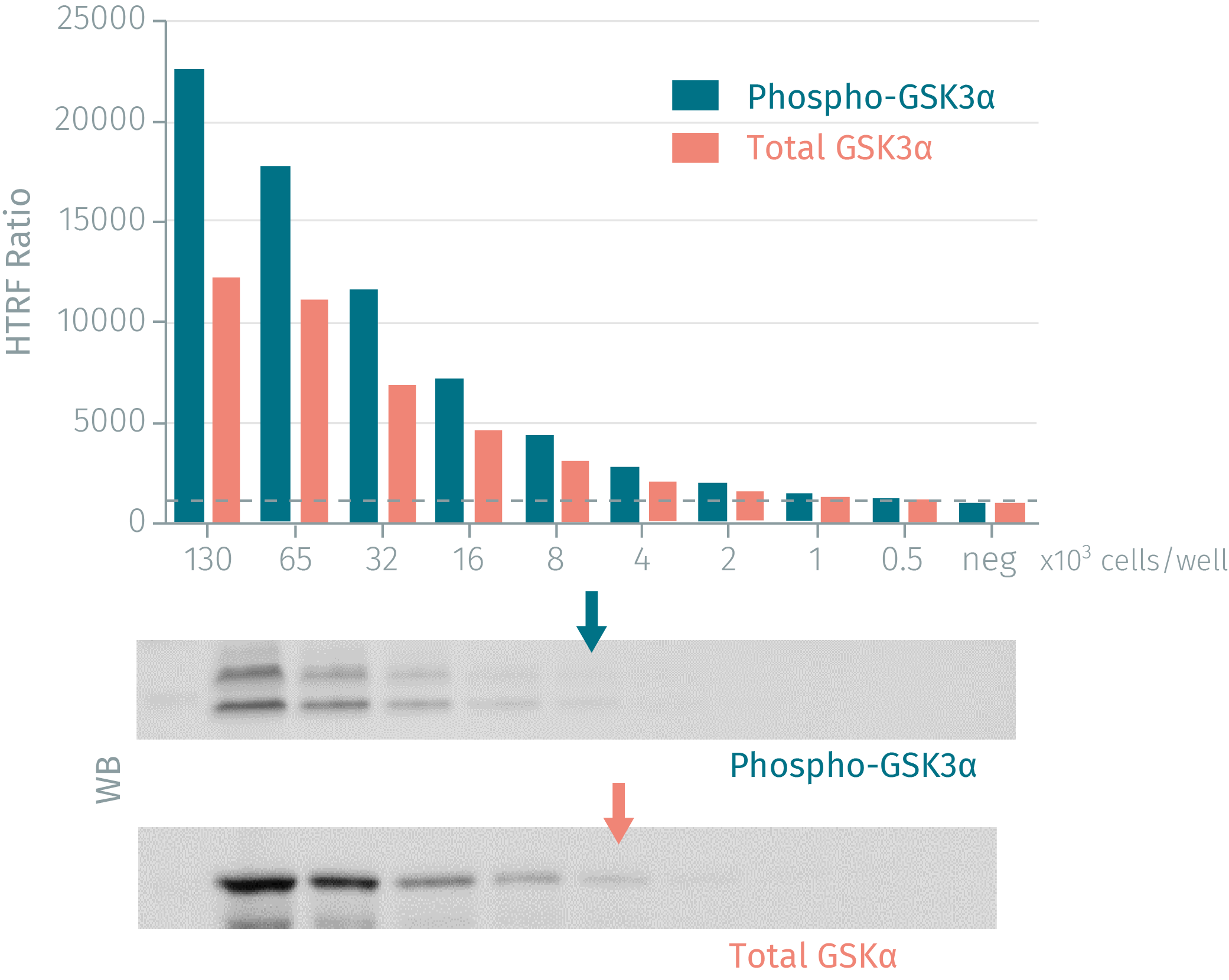

HTRF Human and Mouse Phospho-GSK3α (Ser21) Detection Kit, 10,000 Assay Points






Gsk3a P-s21 Kit - 50,000 Tests
For research use only. Not for use in diagnostic procedures. All products to be used in accordance with applicable laws and regulations including without limitation, consumption & disposal requirements under European REACH regulations (EC 1907/2006).
Product information
Overview
Phospho-GSK3a (Ser21) assay is designed for the robust quantification of GSK3a modulation when phosphorylated on Ser21 as a ubiquitous readout of major pathways. GSK3 is involved in PI3K/AKT signaling, Wnt/ß-Catenin, Hedgehog, Notch, glycogen synthesis, and cytoskeleton polymerization, which control protein synthesis, cell proliferation, migration, inflammation, immune response, glucose regulation, and apoptosis.
Specifications
| Assay Points |
10000
|
|---|---|
| Assay Target Type |
Kit
|
| Assay Technology |
HTRF
|
| Brand |
HTRF
|
| Quantity |
1
|
| Shipping Conditions |
Shipped in Dry Ice
|
| Therapeutic Area |
Infectious Diseases
Metabolism/Diabetes
NASH/Fibrosis
|
| Unit Size |
10,000 Assay Points
|
Video gallery


How it works
Phospho-GSK3a (Ser21) assay principle
The Phospho-GSK3a (Ser21) assay measures GSK3a when phosphorylated at Ser21. Contrary to Western Blot, the assay is entirely plate-based and does not require gels, electrophoresis or transfer. The Phospho-GSK3a (Ser21) assay uses 2 labeled antibodies: one with a donor fluorophore, the other one with an acceptor. The first antibody is selected for its specific binding to the phosphorylated motif on the protein, the second for its ability to recognize the protein independent of its phosphorylation state. Protein phosphorylation enables an immune-complex formation involving both labeled antibodies and which brings the donor fluorophore into close proximity to the acceptor, thereby generating a FRET signal. Its intensity is directly proportional to the concentration of phosphorylated protein present in the sample, and provides a means of assessing the proteins phosphorylation state under a no-wash assay format.

Phospho-GSK3a (Ser21) 2-plate assay protocol
The 2 plate protocol involves culturing cells in a 96-well plate before lysis then transferring lysates to a 384-well low volume detection plate before adding Phospho-GSK3a (Ser21) HTRF detection reagents. This protocol enables the cells' viability and confluence to be monitored.

Phospho-GSK3a (Ser21) 1-plate assay protocol
Detection of Phosphorylated GSK3a (Ser21) with HTRF reagents can be performed in a single plate used for culturing, stimulation and lysis. No washing steps are required. This HTS designed protocol enables miniaturization while maintaining robust HTRF quality.

Assay validation
HTRF assay compared to Western Blot using phospho-GSK3a, total-GSK3a
Human MCF-7 cells were grown in a T175 flask at 37 °C, 5% CO2 until 80% confluency. After a 1.72 µM insulin stimulation for 30 min, cell culture medium was discarded and cells were lysed with 3 mL of supplemented lysis buffer for 30 min at room temperature. Soluble fractions were then collected after a 10 min centrifugation. Serial dilutions of the cell lysate were performed in the supplemented lysis buffer and 16 µL of each dilution were dispensed and analyzed side-by-side by Western Blot and by HTRF. By using HTRF phospho-GSK3a (Ser21) and total-GSK3a cellular assays, just 1,500 cells are sufficient for minimal signal detection, while 12,500 cells are needed for a Western Blot signal. The HTRF cellular assays are at least 4-fold more sensitive than the Western Blot.

Inhibition effect of UCN-01 on the phosphorylation of GSK3 using phospho-GSK3a assay
100,000 human MCF-7 cells were plated in 96 well plates and incubated for 24h at 37 °C - 5% CO2. After incubation with increasing concentrations of UCN-01 (2h), cells were stimulated with insulin at 1.72µM (30min). Medium was then removed and cells were lysed with 50µl of lysis buffer for 30min at RT under gentle shaking. 16 µL of lysate were transferred into a 384-well sv white microplate, and 4 µL of the HTRF phospho-GSK3a (Ser21) detection reagents were added. The HTRF signal was recorded after an overnight incubation.

Insulin dose-response on MCF-7 cells using phospho-GSK3a (Ser21) cellular assay
100,000 human MCF-7 cells were plated in 96 well plates and incubated for 24h at 37 °C - 5% CO2. After incubation with increasing concentrations of Insulin (30min), medium was removed and cells were lysed with 50µl of lysis buffer for 30min at RT under gentle shaking. 16 µL of lysate were transferred into a 384-well sv white microplate, and 4 µL of the HTRF phospho-GSK3a (Ser21) detection reagents were added. The HTRF signal was recorded after an overnight incubation.

Compatibility of the HRTF phospho-GSK3a (Ser21) cellular assays with different cell lines
100,000 or 200,000 cells of different cell lines were plated in 96 well plates and incubated for 24h at 37 °C - 5% CO2. After incubation with or without UCN-01 at 1µg/ml (2h), cells were stimulated with 1.72µM of insulin (30min). Medium was removed and cells were lysed with 50µl of lysis buffer for 30min at RT under gentle shaking. 16 µL of lysate were transferred into a 384-well sv white microplate, and 4 µL of the HTRF phospho-GSK3a (Ser21) detection reagents were added. The HTRF signal was recorded after an overnight incubation.

Simplified pathway
GSK3a Simplified Pathway
GSK3a is active in numerous central intracellular signaling pathways and regulates important cellular processes from proliferation and immune responses, to glucose regulation and apoptosis. GSK3 kinase phosphorylation inhibits the activity of downstream targets. GSK3 is also regulated by cellular localization and by protein complex formation. In the insulin pathway, insulin activates PI3K, which phosphorylates AKT. In turn, activated AKT phosphorylates GSK3a on Ser21 and GSK3ß on Ser9, resulting in GSK-3 inactivation and inducing activation of glycogen synthase by dephosphorylation. Dephosphorylated GSK3 inactivates glycogen synthase, which converts glucose to glycogen. Thus, GSK3 is considered a versatile potential target for various disease research applications.

Resources
This guide provides you an overview of HTRF applications in several therapeutic areas.

SDS, COAs, Manuals and more
Are you looking for technical documents for this product. We have housed them in a dedicated section., click on the links below to explore.


How can we help you?
We are here to answer your questions.






























